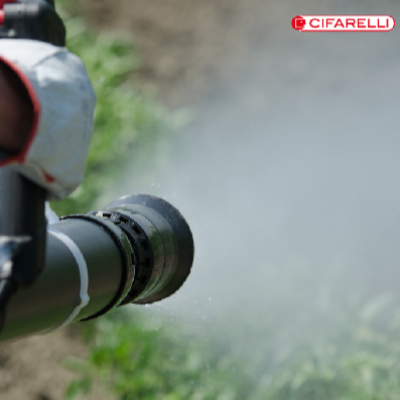17/12/2013
The treatment of horticultural

Being a reality with particular characteristics, to better understand the importance of the treatments in the horticultural farms, some concepts need to be defined first.
Characterized by very short crop cycles throughout the year, horticultural crops in many cases require a greater use of chemicals and technical means, compared to other intensive crops and this, according to the agronomic techniques used, can significantly change the system soil-water-air.
Integrated pest control, a foreseeable future
For this reason, carefully evaluate the principles of good farming practices and taking a peek at what is applied by organic methods, is interesting also because of the EU Directive 128/2009 regarding the sustainable use of pesticides, adopted by the National legislative Decree as of August 14, 2012 and as a result of which, according to the provisions of articles 18 and 19 with effect from January 1 2014, the use of certain key principles of integrated production method for the entire agricultural sector became mandatory.
To good practices should be added, and it is an important concept to keep in mind, the correct use of synthetic substances and equipment available to us, so to proceed to an optimal distribution of the products that will give, as a result, a cost savings and a lower impact on the environment, on the health of consumers but also on the operator assigned to such activities.
But what is meant by integrated production? It is an approach that uses all means of production and of protection of the agricultural output from adversity, designed to minimize the use of synthetic chemicals and rationalize fertilization, in accordance with the ecological, economic and toxicological principles.
The provision shall point out some basic elements and techniques of this practice, including the monitoring of infestations and infections, the use of biological means, proper cultivation techniques and plant protection products characterized by lower risk.
The provision shall point out some basic elements and techniques of this practice, including the monitoring of infestations and infections, the use of biological means, proper cultivation techniques and plant protection products characterized by lower risk.
Rotation, the starting point
Basic principle of the biological method as well as of the traditional approach is to never rotate the crops to them. In this way we will have acted either on soil fertility, increasing and storing it, on the prevention of adverse events made by the pest and on the limitation in the development of weeds.
A rational program of an agronomic management, based on the respect of soil and climatic characteristics and on prevention techniques should provide an adequate rotation with species suitable for the area where one operates, of course, the system that typically characterizes the specialized farm, does not match to the practice of rotations and of the insertion of non-horticultural species with positive action on the improvement of the soil, on the prevention of infestations, and so on.
Foreseeing, in fact, the planting of green manure plants among a crop and the next, increases the organic matter content of the soil, and at least three-year rotations, perform a containment function against bacterial pathogens and fungal pathogens such as Sclerotinia, Rhizoctnia, Fusarioum and so on.
Combining then, a proper agricultural placing, you get the effective drainage of water to prevent the formation of stagnant, favorable to the development of fungal pathogens
Very often it is observed that in traditional companies, the trend towards specialization, for obvious market needs, is very strong. The cultivars used are often genetic selection strongly different from the local population, and finally, there is a great disproportion between the amount of biomass removed and reintegration with crop residues always due to the use of much of the commercial crop.
Just to give a dimension to the context in which we are moving – that of the horticultural – in Italy in 2011 were produced 25.6 million tons of fruit and vegetables (Istat data – National Institute for Statistics) and fruit and vegetable crops, cover an agricultural area that, without counting the surfaces with potatoes and kitchen gardens, is more than 992 000 hectares with an increase of the surface with vegetables against that of fruits; about 463 thousand of companies whose average size is 2.68 hectares, operate on this surface (2010 agriculture census data source Ismea).
Horticulture and mechanization
As well as in all the agricultural field, even in this context is strong the development and introduction of the mechanical component that is predominant between the typical operations of fruit and vegetable production such as fertilizer, tillage, sterilization and weeding, sowing and transplanting, irrigation and fertigation, pesticide treatments and finally harvesting.
Role and main purpose of the mechanization of the operations is certainly the reduction of strain of the operator, the reduction of working hours with economic benefits, but the phenomenon that is “breeding ground” and is having an increasingly prominent role in the planning phase of new machines, is the attention focused on virtuous practices for the environment.
Horticultural crops in general are not very aggressive towards weeds because of the slow initial growth and the short crop cycle that involves rotations in rapid succession. This excludes the use of chemical means especially in post-emergence and post-transplant for technical problems when using poorly selective herbicides for crops in succession and for too long persistences. For this reason, returning to the concepts of the integrated but even more of organic farming, it is important to combine mechanical means with chemicals, but to do so it is necessary to know the cycles and the mechanisms that regulate pests.
M1200 Cifarelli
In the use of synthetic products, within the mechanics which feeds horticultural crops, made up of machines for soil tillage, for sowing mostly of precision, mulchers, machines for transplanting, machines for the crops protection, harvesting, sorting and packaging machines, in the operations of treatment with plant protection products, in addition to fixed installation and boom sprayers, there are also the mist-blowers.
The use of the mist blower, may pose different risks related to the products used and to the safety of the machine. For this reason it is advisable, when purchasing the mist blower to turn to specialized companies that offer timely assistance, efficient technical support and which will direct you towards the most suitable model to specific needs.
Finally, when choosing machines, it is important to prefer models with adjustable shoulder straps and padded back, furthermore it is important to pay attention when lifting the machine and the use of personal protective equipment.

_300x300.png)

_300x300.png)